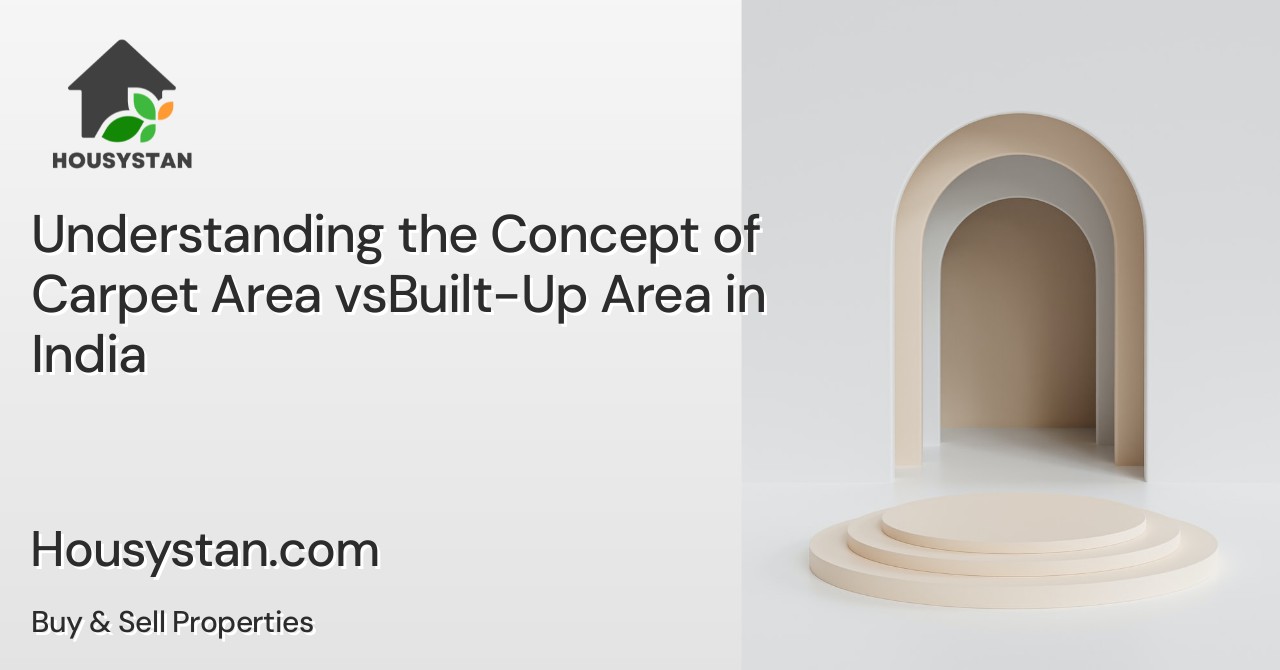Understanding the Concept of Carpet Area vsBuilt-Up Area in India
Read latest blogs and articles from Housystan

The Information mentioned here was last updated on:
9/1/2026Understanding the Concept of Carpet Area vs Built-Up Area in India
When purchasing a home in India, one often finds themselves lost in a sea of real estate jargon. Among the most important terms to understand are "carpet area" and "built-up area." These concepts are crucial because they directly impact the cost and usability of the space you are buying. Let's break down these terms into simple, digestible parts.
What is Carpet Area?
- Verified Tenants/Buyers
- Unlimited Property Listing
- Zero subscription/charges fee
The "carpet area" refers to the actual usable floor area of an apartment or house. In simple terms, it is the area within the walls where you can lay a carpet—it includes living rooms, bedrooms, and kitchens but excludes areas covered by the external walls, balconies, terraces, etc. Imagine the floor space within your home around which you can move freely—that's your carpet area.
For a potential homeowner, understanding carpet area is key because it represents the true living area of the property. Real estate regulations mandate that developers clearly mention the carpet area in their communications, enabling buyers to make informed decisions.
What is Built-Up Area?
The "built-up area" is a broader term than carpet area. It includes the carpet area plus the thickness of the walls and additional utility spaces such as balconies or terraces. Essentially, the built-up area encompasses all the physical space that makes up the apartment or house, as opposed to just the livable spaces. Built-up area typically adds about 15–20% more to the carpet area, depending on the construction style and developer practices.
Understanding the built-up area gives the buyer a better estimation of the total construction space they are getting, though not all of this space will be available for furniture and movement.
Why These Terms Matter
Knowing the difference between carpet area and built-up area is crucial during property purchases because prices are often quoted on the basis of built-up or super built-up area. This can lead to misunderstandings if buyers are unaware of the space they actually have to live in.
Different properties have varying ratios between these areas, depending on the architectural design and developer. A higher carpet area percentage in comparison to built-up area generally translates to better space efficiency. For a prospective buyer, examining these ratios can guide in selecting the most value-for-money properties.
Carpet vs. Built-Up Area: Illustrative Example
Suppose you are considering buying a 1000 square feet apartment. The builder informs you that the built-up area is 1000 square feet. With a common construction practice, the carpet area may be around 700-750 square feet. This means that out of 1000 square feet, only 700-750 square feet are actually usable living space, with the rest being taken up by walls, balconies, and other non-livable areas.
Legal Implications and Updates
In 2016, the Indian government implemented the Real Estate (Regulation and Development) Act (RERA), which revolutionized transparency in the real estate sector. RERA mandates that developers must sell properties based on carpet area rather than built-up or super built-up area. This provides clarity for buyers about what they’re actually purchasing, curtailing deceptive practices and ensuring transparency in property transactions.
Factors Influencing Carpet and Built-Up Areas
Several factors can influence the ratio and perception of these areas:
1. Design and Layout: Architectural design significantly affects how efficiently space is utilized. Clever layouts can create a sense of more space within a limited carpet area.
2. Construction Practices: Different builders have different practices regarding wall thickness, corridor spaces, and balcony allocations, all of which can affect area calculations.
3. Urban vs. Rural Standards: Often, expectations and standards can vary dramatically between urban and rural property development projects. Urban areas might focus on maximizing efficiency of internal spaces, whereas rural areas may offer larger landed spaces with lower construction density.
4. Developer Reputation: Reputable developers are more likely to adhere to norms and regulations. Checking previous projects can provide insight into the typical carpet-to-built-up area ratios they deliver.
How to Calculate These Areas
To calculate carpet area, buyers should look for information in the builder's sales agreement. Often blueprints and floor plans will specify these details.
For a built-up area, you can include the total area mentioned, typically less common spaces like staircases and exclusive balconies but inclusive of walls and other non-residential spaces.
When in doubt, consult a legal advisor, architect, or a knowledgeable real estate consultant to clarify these details and to verify the information provided by developers.
Buying Tips Using Carpet and Built-Up Area Knowledge
Being informed about these concepts allows you to:
- Compare properties based on true usable space.
- Negotiate better terms with developers by understanding what you are paying for.
- Make decisions that align better with personalization needs for interior designs.
- Gauge the property in terms of potential future investments by assessing space efficiency.
Role of Super Built-Up Area
While this article focuses on carpet and built-up areas, the super built-up area is another term often used in Indian real estate. It includes the built-up area plus proportionate space in shared amenities like lobbies, staircases, and lifts. The understanding of this area can further refine your real estate assessment.
Navigating Real Estate with Confidence
Purchasing a property is often one of the most significant investments people make in their lifetime. By understanding these key areas, buyers are empowered to make informed decisions, alleviating concerns over deceptive practices. New regulations and transparency norms have armed buyers with better tools to analyze and negotiate their choices confidently.
Navigating the real estate labyrinth requires awareness and scrutiny. Using this knowledge about carpet and built-up areas, you can stride confidently into your next property deal, ensuring that you know exactly what you are buying — turning the complex real estate jargon into clear and comprehensive choices.